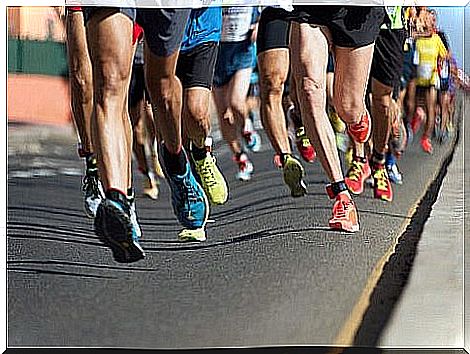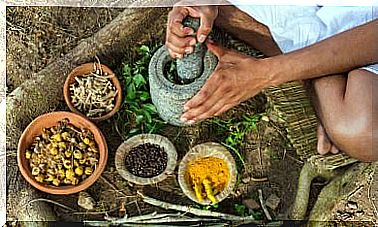The Challenge Of The Marathon: Rituals, Cognitions, Biochemistry And Emotions Of The Runner
The marathon is the maximum of running competitions . It is a real challenge for the body, the bone and muscle structure, the cardio-respiratory system, but it is also a challenge for the mind. Much of the race unifies the brain and emotion with the training state.
Emotions, cognitive images, actions and neurotransmitters in absolute synergy awaken in the marathoner’s scene, where each race is a personal challenge and feedback for the next competitions.
Ritualism in preparation
After the marathon there are still fossil remains , remains that the street sweepers have not managed to clean from crushed water bottles, some piece of bib, hydration gels that shine in the sun, brochures from other races … In short, dead testimonies (although never more alive than in memory) that show the passage of the last sections of the race.
For those who run long distances it is not usual to compete many times a year. There are not many marathons that mark distances of 42, 30 or 21 km in the annual race calendars, although neither does human physiology allow sovereign efforts repeatedly without a considerable margin of recovery.
On the other hand, in the marathon for the amateur athlete there are three moments : the previous week, the during of the race and the week after competition.

Despite the fact that the training in the previous week is based on regenerative or light runs and declines, there is usually some rest, especially of the body, since the runner’s brain does not stop thinking about the route, the times, the memories of the last marathon or road study mentally.
This entire week is tinged with a certain ritualism and cabal of magic even clairvoyance. In addition, there is a certain constant adrenaline load (and elevation of the cortisol level), a certain muscular tension that does not allow a relaxed rest and that increases as the day approaches.
For this reason, it is advisable to take advantage of sleep two days before, that is, if the marathon is on Sunday, sleep well on Friday, because Saturday is a day of tension in which symptoms do not usually appear during the day, but they break out at night when you try to fall asleep or cause you to wake up before the alarm clock goes off.
Two hours before the event, the ritual of the long-distance runner begins to unfold. He knows that the help of solid Vaseline or other elements is miraculous and that there are three key places, since everything that seems banal or insignificant throughout the 42 can become torturous.
The next step is to put on the runner’s main gadgets: his shoes. Of course they are not the new ones: it is always recommended that nothing be released on race day in order to avoid unforeseen hardness, discomfort and friction. Well washed, used shoes bear the runner’s marks: the shape and arch of his foot, the heel support …
At this moment, adrenaline tension is at the service of a hyper-vigilant alert. The muscles are in a tight, bubbling tight inside. It is the same that finds a discharge route in the stomach and intestine and favors urination one and two, up to three times.
His house is silent. It is very early and he has not wanted to wake anyone up with noise of preparations. The teenagers have not yet arrived, the youngest sleeps in his room. Everything is a climate of heat on Sunday, from sunrise on Sunday.
He sits down in the kitchen and eats a plate of pasta for breakfast that he microwaved. It hydrates well, as in the previous days. Eat some fruits. Have a strong coffee: a discreet dose of caffeine puts the runner in tune.
He is nervous. You mentally program yourself with positive images. He puts on the watch checking that it works well, although he uses it every day, today it is different: he must check that it does not fail. It is filled with questions, many that have already been asked. He wonders if he trained well, although his hyper-demand leads him to think that he always lacked a little more. Not every week he totaled, more or less 80 km of depth: he does not know if the runs of 1000 will give the expected results.
He carries a backpack on his shoulder with clean clothes, a fanny pack that he will not use because it hurts his waist and he prefers not to risk it and goes to the door of the building waiting for his fellow club members to pick him up. It’s cool and you say: “ what a good day to run! “, Despite the fact that if it were 40 degrees hot or it rained torrentially, the same thing would be repeated or I would try to see the positive aspect. At this time, the first rays filter through the clouds.
The Loneliness of the Long Distance Runner
Although the long distance runners are accompanied by the displays of affection from friends and family and strangers along the way, deep down they are concentrated with the only company of themselves. Attentive, even if they are with their training group, they try not to lose every moment of emotion that the race brings.
Long-distance runners know that when the start signal is given and the electronic clock starts counting, the first steps are taken slowly given the large number of marathon participants. Steps that increase in speed and become trot and from trot to run as the meters advance.
The concentrated marathoner listens to the rumors of his body and is alert to his tensions, to the muscular pains, to his emotion and to each of the memories that his mind alternates along the way: words of the spouses, the figure of the children that becomes stimulating, people who are no longer …
He gets excited when he passes by and encourages a blind or wheelchair runner, he stimulates those who have stopped his run with visible signs of fatigue (hands that are gripping the waist), sometimes he greets someone who encourages him on the route , others will be super concentrated.
He joins a group that takes his rhythm and thus they throw a few kilometers setting the pace. Try walking a few steps when you stop at a hydration station and drink water and an isotonic drink. He knows he must walk because the times he tried to run and drink at the same time he ended up getting soaked and the water -beyond perspiration- heavy and annoying in the course.
The truth is that the long-distance runner is alone. Only with his soul, his body, his strategy and his emotion. For amateurs , the first ten kilometers offer hope of having a good race, they carry the illusion of slowing down, as long as the pace is regulated and enough air remains for the next 20.
An important goal is to reach the half marathon, although for the complex human mind this point is a hinge to see the glass half full or half empty: it is said ” Come on, we’ve already covered half! ” or ” We have half the race to go! ” . It is also a denunciation of the way the marathoner acts in his life : either he has a negative or a positive predisposition.
If it does not rain it is fantastic, since although the rain refreshes, it also wets the clothes and mainly the shoes and socks. Thus, throughout the race, the runner it will change movement mechanics.
Heat and humidity are also enemies of the long-distance runner. The pavement of the streets in conjunction with the sun make hydration not reach and the mineral salts essential for the muscles to work in a stable way, that is, they resist the effort, are overmined.
What happens is that if the long distance runner feels good muscularly, his mind positively encourages his race. On the other hand, if your muscles are undermined, you can’t even think clearly. You enter into a dangerous overexertion that prevents you from thinking about a strategy.

The 30 km wall and the fighting spirit
The great ghost of the marathon runner’s course is kilometer 30. Something is happening in his mind. Something that is still not well known what it is, but that, to a greater or lesser extent, stands out for the appearance of a set of aberrant thoughts that momentarily affect the enjoyment of the race. However, the organism is wise. At that point in the journey, the benefits of endorphins balance catastrophic thoughts and make pleasure gain ground.
For amateur runners , those last 10 km are often marked by tortuous thoughts, muscle aches, general tiredness and anxiety to finish. The mind does not stop thinking. However, these symptoms usually present in different intensities -and in some cases they do not even occur-, although sometimes they are aggravated by the panorama of the context.
This is a period where concentration can be lost and the surroundings are observed. Furthermore, one is more dependent on the outside than on the inside: more attention is paid to the corridor that surpasses us than to the one that we surpass.
The truth, and in synthesis, is that in this dimension of the journey a series of factors come together and many of them show contradictions:
- Cognitive: spontaneous negative thoughts that are confronted with positive thoughts.
- Organic : deficiency of mineral salts, muscle aches, cramps due to overexertion, injuries and sores or blisters due to friction that are confronted with the tendency of the body to stabilize these dysfunctions.
- Emotional and chemical: anxiety to finish or fights due to bodily conditions in confrontation with the feeling of well-being caused by the endorphin quota in the blood. And at the central nervous system level, the motivating dopamine and persistent cortisol.
However, these factors are not dissociated but are in total synergy and influence each other. For example, a simple positive thought can generate doses of endorphins and dopamine that generate the necessary encouragement to undermine muscle pain.
On the other hand, in that kilometer 30 some other hydration gel is distributed, a kind of molasses that reminds us of the cough syrup of our childhood, but these have their risk. Around this stage of the race, carbohydrate reserves decrease and the ingestion of a gel pack implies injecting a quota of a high glycemic index into the body. Our body, then, detects a rise in blood glucose and immediately secretes insulin to counteract glucose levels, which generates the opposite effect to the desired one.
Also, motivation is needed at those times. The marathoner stimulates himself, says things to himself, internally cheers as if he were the first to cross the finish line. Sometimes he is impressed by the support of the people who witness the marathon. It is a continuous choreography that goes from the internal world to the outside: internal and external voices stimulate and motivate the runner, especially at the moment of his decay.
Beyond these technical explanations, the marathoner has a great fighting spirit and makes sacrifice a form of dedication, an icon of his work in pursuit of reaching the goal. And all this is enjoyed.
This proximity to the objective is observed when the kilometers traveled are no longer counted, but the ones that are missing are counted. In the last 5 kilometers when there by the 37 a discount time is concocted: not only are there a few kilometers but there is little time left for the arrival.
Nothing is the same after the 42,195 meters in the marathon
Internally, it is not that the pain disappears, it is closer to ending, then the focus of the pain shifts to the possibility of ending. Thus the kilometers pass. In fact, when it is kilometer 40 that appears in front of the eyes of the amateur runner , he practically feels that he has arrived. Those last 2,195 meters were they roll .
The anticipatory images of arrival make the endorphins work at full capacity and, incidentally, undermine the last pains that plague you. It is more in the arrival than in the race. The focus is the last straight.

The final of the marathon
When the kilometer sign announces 41, that’s the last kilometer of victory. In the last kilometers, the brand does not matter anymore, the most important thing is to arrive, heroism is coming.
The runner thinks that his family, his wife, his children, his parents, also a friend, when not, some of his friends who run like him, but did not dare to the marathon, will be at the finish. He feels a chill when he sees that there are more people cheering: it is the indication of the prolegomena of the arrival. Listen to them Bravo! Come on, there are 300 meters to go! Well, well, the force is over! , the applause, the screams …
Enter the final stretch, see the finish line from afar. Pick up your stride, straighten your body. He searches among the people for the face of his son, his wife, his father: he searches until their breath surprises him. He gets emotional, sometimes, even tears appear. It no longer matters the position or the brand. You feel that you have achieved victory because you have arrived. He has only a few meters to go and he crosses the finish line raising his arms and looking at the sky.
Life has wonderful sensations, but that moment, the arrival of the marathon runner, is one of the emotions that deserves to be experienced with the maximum intensity. Even days later, the marathoner continues to remember and relive each section of the race and vibrate in his imagination the whole experience in images and feelings until he schedules his next race. There he goes, he with his loneliness, towards the next challenge.









